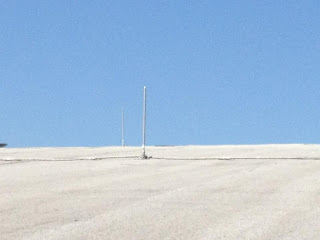1. Installed thermometer/hygrometer on the silver quarter-circle next to the kiosk, where the electronics platform will go, using double-sided tape; I will leave it there for several weeks (until I get back from China probably), to measure the maximum temperature & maximum relative humidity over this period. I asked Reed to remove it and check the values if he notices the display going dim, since this would probably indicate the battery is dying. I don't know if it will really last the 7 weeks until I get back.
2. Went up on roof, and took a photo of the air vent we will use to feed the GPS antenna cable into the building:
 |
| Air vent on the roof of CLC that we will use to feed the GPS antenna cable into the building. We will ground the lightning surge protector to the grounding cables seen here. |
3. Also, while on roof, measured the slope of the roof near the center point using the iCarpenter app on my iPhone. Actually, the CLC staffer who let me up onto the roof was nice enough to do the measurement for me, following my instructions (climbing up on the planetarium roof would be tricky for one who warps space and time as strongly as I do). He measured the slope at two points near the lightning rod at the center of the roof; one measurement was slightly below 9 degrees and the other was slightly above, so we'll say 9 degrees is the slope of the roof. I'd guess that's probably accurate to within +/- 1 degree. Close enough for government work. Below is a close-up of the area near the lightning rod where he did the measurements. You can't see much from this angle, but you get the idea...
Lightning rod at center of planetarium roof.
I'm currently thinking of placing the GPS antenna
somewhere nearby.
Note to self: Before we actually place the order for the new OCXO board, it would probably be a good idea to change the width of the CLK_OUT trace from 50 mils to something like 10-20, to reduce parasitic capacitances, which otherwise might smear out our rise time a bit.

No comments:
Post a Comment